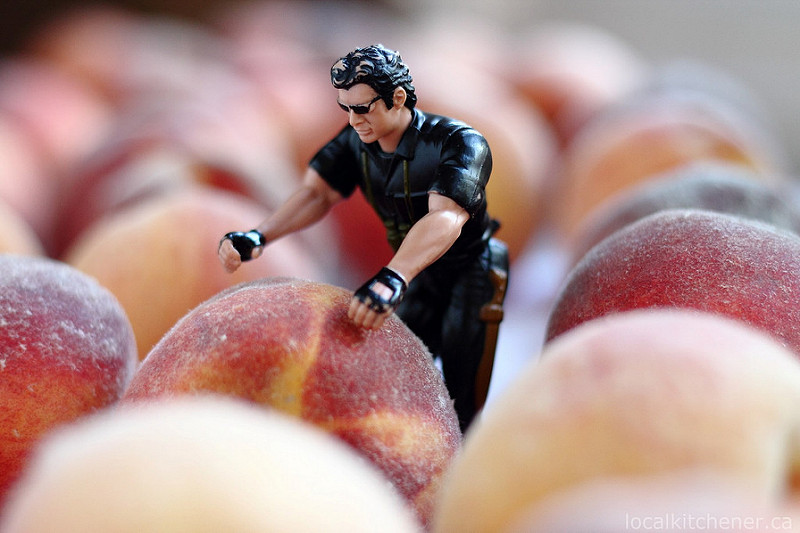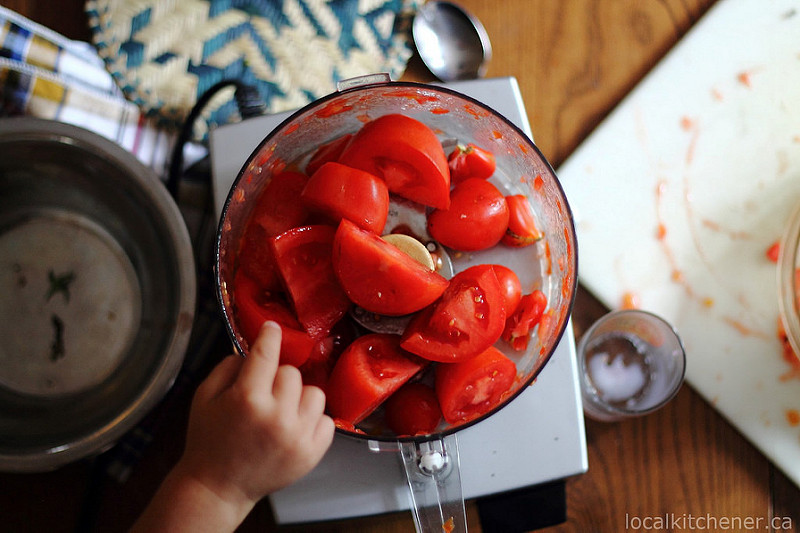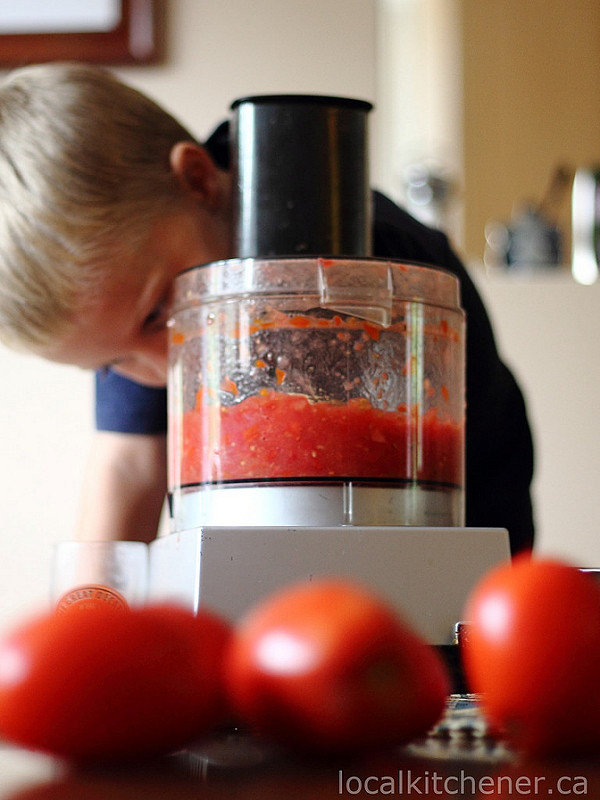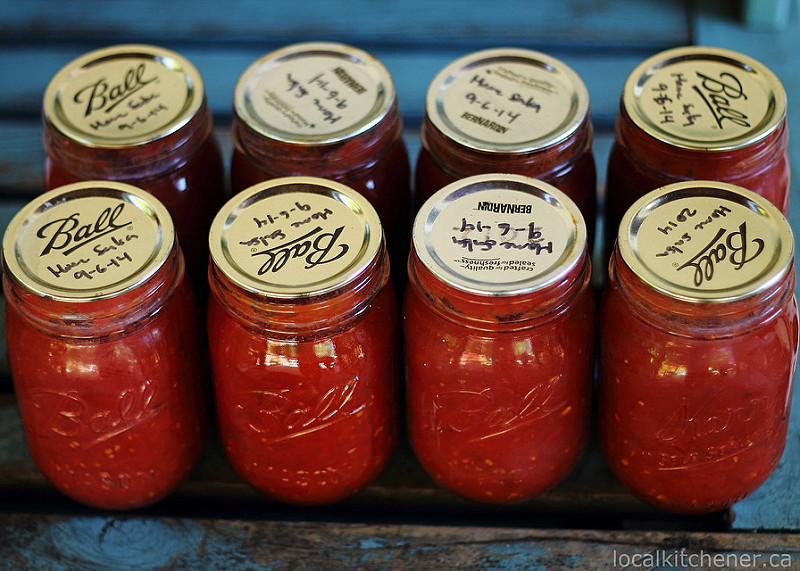Canning an (Almost) All-Garden Salsa
Alright, a few days ago I got a bit romantic about our love of preserving . Now, however, we’re in crunch mode so I’m feeling slightly less amorous about the whole thing.
For one thing we have a huge bag of tomatoes on the floor, another full of peppers, and peaches are covering our hutch.  Luckily eventually I find the right attitude and energy and I get back to feeling good about all this cooking and preserving.  Plus everyone here works really hard:
Yesterday my young assistant and I tackled the homegrown tomatoes by turning them into an entirely homegrown salsa. Well, it was entirely homegrown until we realized that it was way too runny because we had thrown several Brandywine tomatoes into the mix. Thus there was an addition to the recipe of a small can of tomato paste.
Ahhh well, we can’t always be purists and that’s probably okay. Luckily there is no rule book when it comes to eating local, just a desire to eat as close to home whenever possible.
Although this salsa is for canning we’ve also been enjoying lots of fresh salsas with whatever ingredients we have on hand. The most obvious thing of course is the peaches, but we’ve found that most fruits work well in salsa as do many unconventional vegetables.
Cucumbers, as pictured above, are an amazing addition to a fresh salsa. They bring a light fresh flavor of their own but also soak up all the flavors of the foods around them while adding a nice crunch and color to the final product.
Radishes are great too, for the combination of spicy flavor, color, and crunch. Recently we added kohlrabi to a salsa, which was great too! It turns out that as long as you meet a few requirements pretty much any fruit or vegetable can go in a salsa. Here are our guidelines for creating unique original salsas:
- Some crunchy things, like any of the following, nicely diced in small pieces: onions (any colour), sweet peppers, radishes, cucumbers, apples…
- Some sweet things, also nicely diced: peaches, plums, nectarines, apricots, apples, pears, watermelon, cantaloupe, honeydew, strawberries, tomatoes, sweet corn…
- Some fillers, (diced if necessary): black beans, cucumbers, extra tomatoes, fruit…
- For some spice and zing: hot peppers (diced, or dry crushed red peppers if you don’t have anything fresh), cilantro, lime juice (or local options would be cider vinegar or verjus if you can find it), garlic, a dash of cumin, and salt and pepper.
I recently shared 5 salsa recipes on the Bailey’s Local Foods blog so check those out for more inspiration. Today’s recipe is for an (almost) all homegrown salsa for canning. You’ll need a pressure canner for this recipe because there is not enough added acid (vinegar or lemon/lime juice) to make it fully safe for water bath canning. If you added a whole cup of vinegar it would likely be safe for water bath canning, but we didn’t want that much vinegar flavor in this recipe.
This recipe yields 7-9 pints, depending on how much you cook it down.
- 4 litres tomatoes
- 5 jalapeños
- 3 green onions, with stems
- 1 small handful of coriander (cilantro seeds)
- 2 cloves garlic
- 1 small can tomato paste
- ½ cup raw cider vinegar
- 1 tbsp. salt
- Core the tomatoes and puree them in small amounts until just chopped. Measure tomatoes as you go until you have roughly 4 litres (or quarts). Add the chopped tomatoes to a pot and bring to a simmer.
- Puree the jalapeños, onions, coriander, and garlic. Add these and the tomato paste, vinegar, and salt to the tomatoes after they have simmered for about 15-20 minutes. Cook until the salsa is thickened a bit, another 20-30 minutes.
- Prepare 8 pint (500ml) canning jars and a pressure canner. Fill jars leaving ½ inch headspace. Process at 10 lbs pressure for 30 minutes. (Canning pressure and time based on recipe from Putting Food By).
Enjoying the linkup party at She Eats’ Fresh Foods Wednesday , thanks Kristy!







September 10, 2014 @ 2:23 pm
I was just thinking about making salsa today. I bought some cilantro from the store. And now that ou mentio it, I have some cucumbers that need to get used up. Thanks for the idea. Pinning.
suzy recently shared… pumpkin cocoa oatmeal bites
September 10, 2014 @ 7:37 pm
Thanks, Suzy!
September 11, 2014 @ 6:18 pm
I’m new to canning. Since this is pressure-canned rather than hot water bath-canned, if my tomatoes are less watery it would be safe to omit the tomato paste without otherwise altering the recipe, right?
September 11, 2014 @ 8:10 pm
Hi Rachel, I think it would definitely be fine to omit the paste. Best of luck and happy canning!
The Weekly FBC News for Sept 15th, 2014 | Food Bloggers of Canada
September 15, 2014 @ 3:39 am
[…] garden salsa being prepped for canning by The Local Kitchener as seen in the FBC Food Photography Flickr […]
September 10, 2015 @ 7:35 pm
Hi Jon (and handsome helpers)! When you say “5 jalapenos” are you including the seeds or no seeds?
September 10, 2015 @ 8:58 pm
Hey Carol, great question! I usually take them out because I want to maximize flavor and minimize heat (on behalf of those helpers!). Thanks for stopping by the blog 🙂